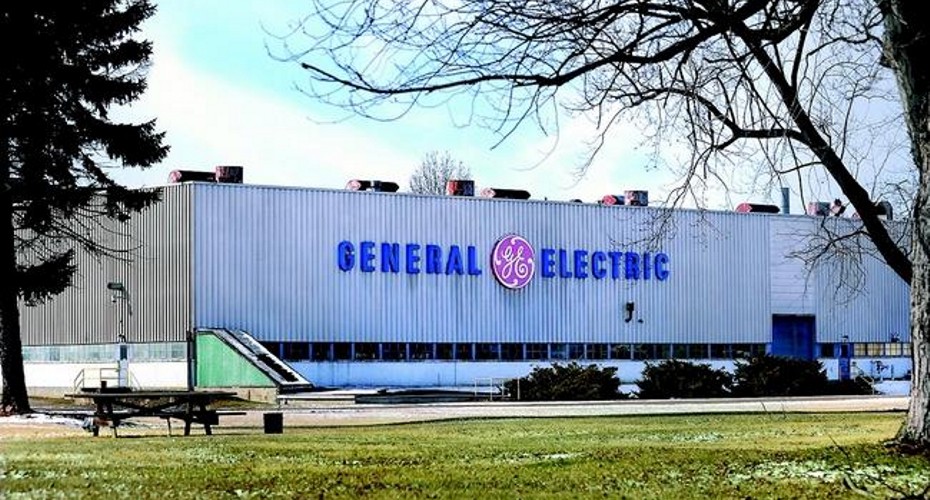|
|
|
Introduction
The Dover Products Plant of the General Electric Company of America did not produce complete lamps, but was a component factory that supplied materials to other final-assembly lamp and electronic tube plants. One part of the operation was engaged in the drawing of molybdenum wire, while the other produced specialised components formed from wires of other metals bent into specific shapes - for instance the arc tube support assemblies of discharge lamps. The factory opened prior to 1913 and it is believed to be still operational.
|

General Electric Dover Products Plant, 2010. |
| Address |
200 West Broadway, Dover, Ohio 44622, U.S.A. |
| Location |
40.5173°N, -81.4724°E. |
| Opened |
Prior to 1913. |
| Closed |
August 2017. |
| Products |
Moldybdenum wire, Molybdenum Foil, Platinum-Clad Molybdenum, MolyCarb Electro-discharge-machining wire, formed wire assemblies. |
History
The factory appears to have commenced operations around 1913 under the name of the Dover Rolling Mill, presumably as a site for the rolling of sheet metals. Its name was later changed to the Reeves Mill, and prior to 1944 it has been taken over the American Sheet and Tin Plate Co. In that same year, General Electric moved into the building to produce molybdenum wire for parts of walkie-talkie radios used during the Second World War. The operation was a success and in 1946 GE purchased the complete site, to set up an experimental and development operation. This resulted in the August 1950 start-up of full scale drawing of molybdenum wire. In 1958 a building addition was made, which increased the manufacturing space to three times that of the original 1944 operation. In 1964 a major 5,000 investment in new machinery was made, ,000 of which was devoted to a state-of-the-art new molybdenum rolling mill. The workforce at the time consisted of approximately 160 plant workers and 40 office employees. Dover reached the peak of its operations during the 1990s, but then began to decline following GE's takeover of the Hungarian Tungsram company, whose low labour cost facilities in Eastern Europe proved to be more cost competitive. The plant gradually dwindled in size, decreasing to around 40 staff in 2010. In August 2016 the headcount dwindled further to just 30 staff, and it was announed that the plant would close a year later.
|
Production
The Dover operations commence with the milling, sifting, bleaching and blending of molybdenum powder. That fine raw material is then sent to the nearby Tungsten products plant for pressing into 21-inch long ingots weighing about 12 pounds, which are sintered at high temperature to improve mechanical strength. After returning to Dover, they are swaged into rods measuring 90 feet in length, this operation reducing the diameter to 3/16th inch. Following this treatment the wire is sufficiently ductile that it can be reduced in diameter by relatively standard high-temperature wire drawing processes - which may draw the wire down to as little as 0.0012" in diameter - each of the original ingots yieding approximately 400 miles of such wire. Thereafter the wire finds numerous applications in electric lamps and vacuum tubes, as well as as the travelling wire in electro-discharge machining techniques.
|
| 1 |
Various brochures of GE Lighting Components Organisation
|
| 2 |
The Back Alleys and Backstories Historic Tour, Historic Canal Dover Association.
|
| 3 |
GE Dover Wire Plant produces Molydenum Wire for new PowerGroove Fluorescent Cathodes, The Daily Reporter, 15th April 1956 p.5.
|
| 4 |
GE Dover Plant - A Community Asset, The Daily Reporter, 25th January 1964 p.15.
|
| 5 |
GE Trims Jobs at Dover Products Plant, Timesreporter.com, 29th January 2010.
|
| 6 |
GE Closing Dover Lighting Factory expected in August 2017, J.Baker & N.Molnar, The Times Reporter, 23rd August 2016.
|
| 7 |
GE Lighitng to Close More Plants, LighTED Magazine, 24th August 2016.
|
|
|
|
|
|